When 10-year Toby Douglas’ house was threatened by a bushfire in New South Wales in 2013 he made this stop-action video to help make residents aware of an app distributed by the New South Wales Rural Fire Service and of the importance of having a bushfire survival plan. Last month the video was uploaded to YouTube, garnering much attention and praise for the young filmmaker.
Category: Uncategorized
30 fires burning across New South Wales

Firefighters in New South Wales, Australia, are battling 30 fires in their state, 17 of which are uncontrolled.
Below is an excerpt from an article at ABC news:
The Hunter region fire is burning west of Teralba on Rhondda Road behind a quarry and is sending large amounts of smoke over the area.
Paul Best from the RFS said the fire was being pushed east by westerly winds.“People in Teralba might start seeing some embers falling and they’ll definitely be seeing smoke,” he said.
“There has been a request for aircraft and there will be some aircraft attending that fire.”
A separate bushfire in the Upper Hunter is still burning near the Goulburn River National Park, covering 25 hectares. More than 20 firefighters are on the ground fighting the blaze at Gungal, with four aircraft involved in the operation. Strong winds are producing unfavourable conditions, pushing the fire closer to the national park.
Firefighters are also battling a blaze at Budda Creek, in remote bushland within Yengo National Park, in the Hawkesbury region of Sydney. That fire had burnt more than 220 hectares, the RFS said.
There are two fires burning in a similar vicinity, started by lighting strikes from storms that went through the area yesterday.
RFS Inspector Ben Shepherd said there would be a large concentration of firefighting efforts in the Hawkesbury region in the coming weeks, with large fires burning in the area.
The NSW RFS video below is from the Budda Creek Fire near Hawkesbury.

Fire Aviation has two videos of a DC-10 air tanker dropping on fires in New South Wales.
Firefighting robots
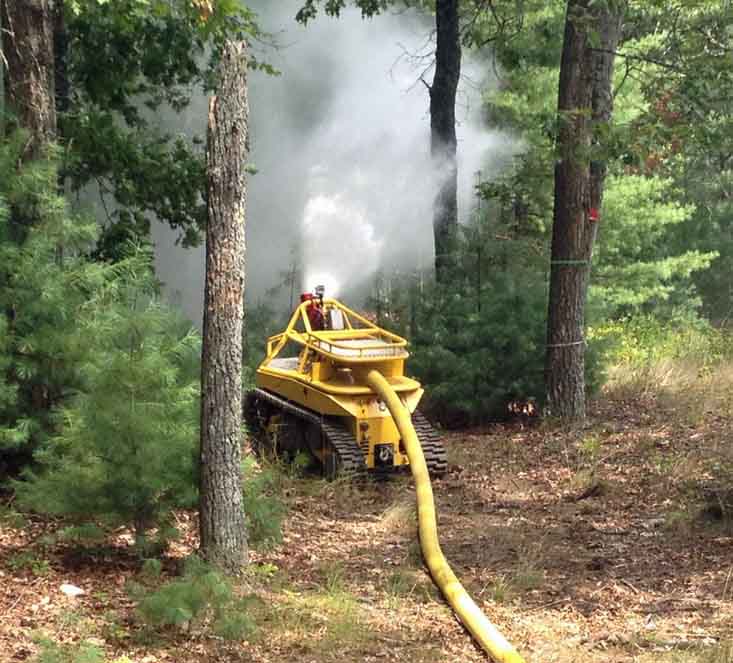
Will firefighting robots ever replace human firefighters? Not on a large scale in the near future, but there have been advances in technology in recent years that has resulted in them being used on actual fires. There is no question that they could be useful in certain types of incidents where the environment would be very dangerous for humans, such as hazardous materials, radioactivity, or a propane tank that could explode (or BLEVE).
Most of the firefighting robots in development or being used today are controlled remotely, are tethered by a fire hose which supplies water, and they have infrared and standard cameras which transmit images back to the operator.
The Thermite robot, pictured above, is small enough to be able to go through an average sized door in a structure. The video below features this machine.
Being used now in New South Wales, Australia is a much larger robot made in Germany, called a Turbine Aided Firefighting machine (TAF 20).
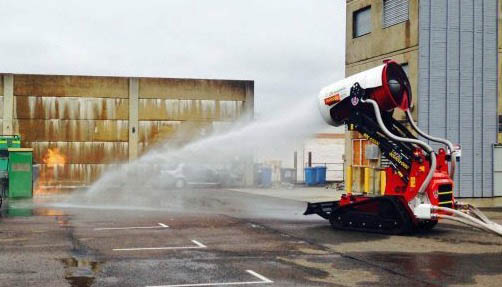
The $310,000 TAF 20 can spray water mist or foam from 60 meters (196 feet) and blast water up to 90 meters (295 feet). It was used last week at a factory fire in Sydney where NSW Emergency Services Minister David Elliot said it proved its effectiveness, according to ABC news.
“It will be of great use for our firefighters in battling other large and complex fires, including bushfires,” Mr Elliot said.
Lockheed Martin, which recently demonstrated a flying firefighting robot is also developing a ground-based machine they call the Fire Ox.
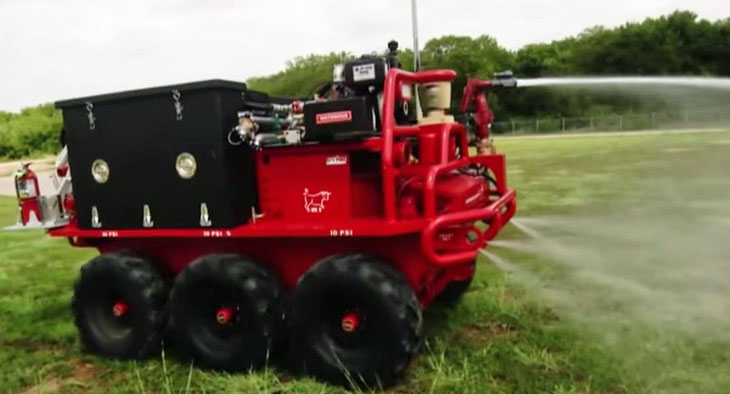
The Fire Ox is self-sufficient, in that it is not dependent on a tethered fire hose since it has an on-board water tank. It appears to be designed for wildland fires and haz-mat incidents. It can be operated with a game-style controller, programmed to follow a predetermined course, or can follow a person walking in front of it.
(UPDATE December 14: we found out today that the fire suppression package on the Fire Ox was built by BFX Fire Apparatus, one of our supporters.)
The U.S. Navy has been researching the use of robots to help deal with fires on board ships, the nightmare of sailors who are stuck on a vessel in the middle of the ocean.
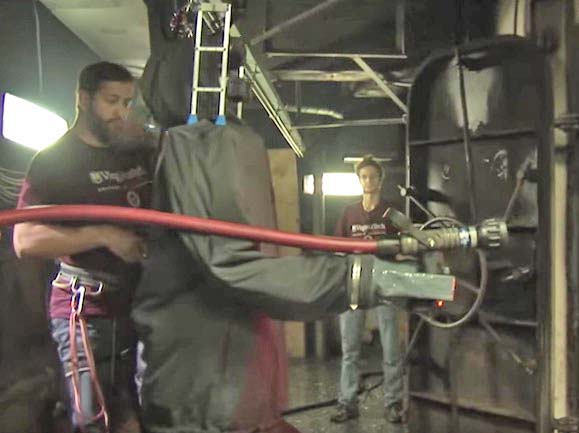
Their SAFFiR team is working on a humanoid robot that walks like a person and carries a fire hose. They are far from having a version that has anything like the mobility of a human, but they have made significant progress in recent years. One feature they are working on is to teach the machine to follow orders by interpreting and acting upon gestures.
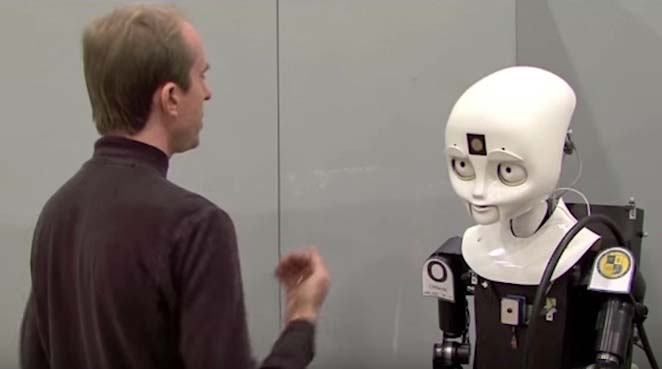
The Smokey Generation: Wildland Fire Oral History Project

Wildland firefighting is a unique occupation, very different from structural firefighting and any other job, actually. It is a niche line of work, an amalgam of professional athlete and warfighter. Few people outside of the relatively small pool of those who have experienced it have a good understanding of how wildland firefighters live and work — the frequent or constant travel, the extreme physical demands over an extended time, the camaraderie of the crews, the feeling of accomplishment, and the occasional adrenaline rush.
These folks have stories to tell. Some of them are fun and entertaining, and many are embedded with lessons that can help educate those just beginning their careers. It would be a shame to allow their hard earned knowledge to fade away.
Betheny Hannah has embarked on a project to preserve some of those memories and lessons, creating The Smokey Generation, a collection of video interviews with firefighters. Having worked as a hotshot firefighter for six years and a chain saw instructor, she knows the jargon and what questions to ask. On her website, which was designed as part of her Master’s thesis project, and on Vimeo, she has posted interviews with dozens of firefighters. Most of the individual interviews have been broken down into several short recordings, each on a singular topic, lasting just a few minutes so it can be a little overwhelming when browsing through over 250 of them on Vimeo. On her website they can be sorted by person and topic.
This summer Ms. Hannah initiated a Kickstarter project to raise funds to attend and interview some of the 900 attendees at the smokejumper reunion in Missoula.
Several videos are posted below. The first was produced by STIHL, the chain saw folks, in which she is featured as part of the company’s Real People campaign. The rest are from The Smokey Generation. Beginning with the second, the descriptions are below the video.
(Vimeo, which is an excellent service, usually, seems to be having problems the day we posted this article, and you may have trouble starting some of the videos.)
Ariel Starr, Redding Smokejumper in 2012 and Missoula Smokejumper from 2013-Present (2015), tells an amusing story about her first jump in her home state of Alaska.
Charlie Caldwell, retired Hotshot Superintendent and Smokejumper, talks about how he got his start in his career, along with some information about the beginnings of the Redding Interagency Hotshot Crew program.
Ronald Stephens, Missoula Smokejumper from 1946-1947, describes his involvement with the 1947 water bomb project, a semi-secret USFS experiment in partnership with the Army Air Corps.
Ken Jordan, retired Hotshot Superintendent, describes his perception of the characteristics that make an ideal Hotshot and talks about the draw of working with good people early on in his career. Interviewed: 4/2014
(Each thumbnail at the bottom tells a new story)
Gina Papke, current Program Specialist and former Hotshot Superintendent, shares some of her memories and thoughts on her experience leading up to and after the South Canyon Incident.
Jon Stewart returns to Daily Show to shame Congress about health care for 9/11 responders
Get More: Comedy Central,Funny Videos,Funny TV Shows
Former Daily Show host Jon Stewart shares his attempts to interview senators about the renewal of the Zadroga Act, which provides health care to 9/11 first responders.
One organization’s plea to fix the wildfire funding problem
It is incredible that Congress has failed to adequately fund the suppression of wildfires, an issue they have ignored for years and has broad multi-party support.
Western Priorities posted this video today with the following description:
The U.S. Forest Service now spends more than half of its budget fighting wildfires. Unlike other natural disasters, Congress does not provide separate funding for the largest fires, forcing the Forest Service to delay or abandon forest management that could reduce or prevent fires in the future.
This cycle of neglect must stop now. We call on leaders in the House and Senate to pass a wildfire funding fix as part of the omnibus budget negotiations this month, so wildfire funding is secure for the 2016 fire season.
